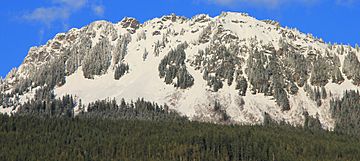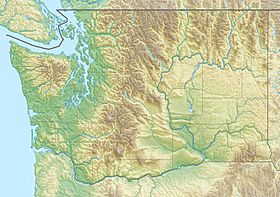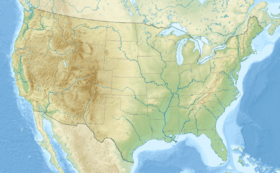Sauk Mountain facts for kids
Quick facts for kids Sauk Mountain |
|
|---|---|

Sauk Mountain, west aspect
|
|
| Highest point | |
| Elevation | 5,541 ft (1,689 m) |
| Prominence | 1,621 ft (494 m) |
| Geography | |
| Location | Skagit County, Washington, U.S. |
| Parent range | North Cascades |
| Topo map | USGS Sauk Mountain |
| Type of rock | Greenschist |
| Climbing | |
| First ascent | 1895 G. O. Smith |
| Easiest route | Sauk Mountain Trail and scrambling |
Sauk Mountain is a mountain peak in Washington state. It stands at 5,541-foot (1,689-metre) tall. You can find it in Skagit County, just north of Rockport State Park.
The mountain is part of the Mount Baker-Snoqualmie National Forest. It is west of the main North Cascades mountain range. Sauk Mountain is about nine miles east of Concrete, Washington.
A popular two-mile trail leads to the top of Sauk Mountain. From the summit, hikers get amazing views. You can see Mount Baker, Mount Shuksan, and the Picket Range.
The name "Sauk" comes from the Sauk River. This river joins the Skagit River right near the mountain. The river's name comes from the Sah-kee-ma-hu people. They are part of the Sauk-Suiattle tribe. Water from Sauk Mountain flows into the Skagit River.
Mountain Weather: Sauk Mountain's Climate
Sauk Mountain has a "marine west coast" climate. This means it's near the ocean, which affects its weather. Most weather systems come from the Pacific Ocean. They travel northeast towards the Cascade Mountains.
When these weather systems hit the North Cascades, they are forced to rise. This is called orographic lift. As the air rises, it cools down. This causes a lot of rain or snow to fall on the mountains.
The west side of the North Cascades gets a lot of precipitation. This is especially true in winter, when there's heavy snowfall. Winters are often cloudy. However, summers usually have clear skies. This is because high-pressure systems form over the Pacific Ocean.
Because of the ocean's influence, the snow tends to be wet and heavy. This can lead to a high risk of avalanches.
Sauk Mountain's Geology: How It Formed
The North Cascades mountains have very rugged land. They feature sharp peaks, deep valleys carved by glaciers, and tall rock spires. These amazing shapes were created by geological events over millions of years. These events caused big changes in the land's height.
The Cascade Mountains started forming millions of years ago. This was during the late Eocene Epoch. At that time, the North American Plate was slowly moving over the Pacific Plate. This movement caused many volcanic eruptions.
Also, small pieces of the Earth's crust, called terranes, came together. These pieces formed the North Cascades about 50 million years ago.
During the Pleistocene period, which began over two million years ago, glaciers played a big role. These huge ice sheets moved forward and backward many times. As they moved, they scraped away the land. They left behind piles of rock.
The "U"-shaped valleys you see today were carved by these glaciers. The mountains' tall peaks and deep valleys were mainly formed by two processes. These are uplift (when land rises) and faulting (when rocks break and move). Glaciation also helped shape the land.




